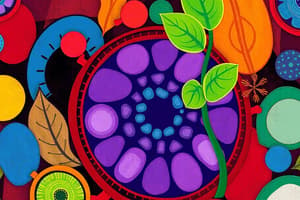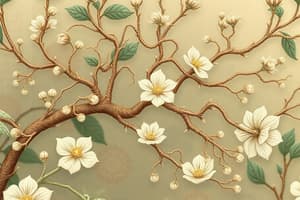Podcast
Questions and Answers
Which factor influences plant communities significantly?
Which factor influences plant communities significantly?
- Soil texture
- Climate change
- Predation (correct)
- Fertilizer use
What process is NOT part of plant physiology?
What process is NOT part of plant physiology?
- Photosynthesis
- Respiration
- Transpiration
- Nutrient absorption (correct)
Which plant adaptation is essential for survival in specific habitats?
Which plant adaptation is essential for survival in specific habitats?
- Branch angle
- Flower size
- Root depth (correct)
- Leaf pigment color
Which statement about the economic importance of plants is incorrect?
Which statement about the economic importance of plants is incorrect?
Which plant hormone is primarily responsible for growth regulation?
Which plant hormone is primarily responsible for growth regulation?
What is the primary focus of botany?
What is the primary focus of botany?
Which plant structure is primarily responsible for photosynthesis?
Which plant structure is primarily responsible for photosynthesis?
What is the role of meristems in plants?
What is the role of meristems in plants?
How do plants primarily reproduce sexually?
How do plants primarily reproduce sexually?
Which group of plants is characterized by having specialized vascular tissues?
Which group of plants is characterized by having specialized vascular tissues?
What aspect of plant ecology is primarily studied?
What aspect of plant ecology is primarily studied?
What is a key factor that influences plant growth patterns?
What is a key factor that influences plant growth patterns?
Which group of plants lacks specialized vascular tissues?
Which group of plants lacks specialized vascular tissues?
Flashcards
Botany definition
Botany definition
Botany is the study of plants, covering their structure, function, reproduction, and evolution.
Plant tissues
Plant tissues
Specialized plant parts for transporting water, nutrients, and other substances throughout a plant.
Roots function
Roots function
Roots anchor plants and absorb water and minerals from the soil.
Stem function
Stem function
Signup and view all the flashcards
Leaves function
Leaves function
Signup and view all the flashcards
Plant reproduction types
Plant reproduction types
Signup and view all the flashcards
Sexual reproduction (plants)
Sexual reproduction (plants)
Signup and view all the flashcards
Pollination
Pollination
Signup and view all the flashcards
Plant growth regions
Plant growth regions
Signup and view all the flashcards
Plant evolution
Plant evolution
Signup and view all the flashcards
Plant diversity types
Plant diversity types
Signup and view all the flashcards
Vascular plants
Vascular plants
Signup and view all the flashcards
Plant Ecology
Plant Ecology
Signup and view all the flashcards
Plant communities
Plant communities
Signup and view all the flashcards
Plant adaptations
Plant adaptations
Signup and view all the flashcards
Plant Physiology
Plant Physiology
Signup and view all the flashcards
Photosynthesis
Photosynthesis
Signup and view all the flashcards
Respiration
Respiration
Signup and view all the flashcards
Transpiration
Transpiration
Signup and view all the flashcards
Plant hormones
Plant hormones
Signup and view all the flashcards
Economic Importance of Plants
Economic Importance of Plants
Signup and view all the flashcards
Study Notes
Introduction to Botany
- Botany is the scientific study of plants, encompassing their structure, function, growth, reproduction, evolution, and distribution.
- It explores a vast array of plant life, from microscopic algae to towering trees.
- Plant diversity is immense, showcasing a wide range of adaptations to various environments.
Plant Structure and Function
- Plants possess specialized tissues for conducting water, nutrients, and other essential substances throughout the plant body.
- Roots anchor plants and absorb water and minerals from the soil.
- Stems support leaves and transport materials between roots and leaves.
- Leaves perform photosynthesis, converting light energy into chemical energy.
- Specialized structures, like flowers and fruits, are central to plant reproduction.
Plant Growth and Development
- Plant growth is characterized by the development of new tissues and organs.
- Growth patterns in plants are influenced by internal and external factors, including hormones and environmental conditions.
- Meristems are regions of actively dividing cells responsible for plant growth.
- Different growth patterns emerge in various plant species.
Plant Reproduction
- Plants reproduce sexually and asexually.
- Sexual reproduction involves the fusion of male and female gametes.
- Pollination is vital for fertilization in flowering plants.
- Asexual reproduction involves the development of new plants from vegetative structures.
Plant Evolution
- Evolutionary relationships among different plant groups are studied to understand the origins and diversity of plant life.
- Various plant groups exhibit diverse evolutionary adaptations for survival in different environments.
- Fossil evidence plays a crucial role in reconstructing the history of plants.
Plant Diversity
- Plants are categorized into various groups based on evolutionary relationships and characteristics.
- Major plant groups include vascular and non-vascular plants.
- Examples of vascular plant groups include ferns, gymnosperms, and angiosperms.
- Non-vascular plants, like mosses, lack specialized vascular tissues.
- Plant diversity is studied to understand the roles plants play in ecosystems.
Plant Ecology
- Plant ecology is the study of plant interactions with their environment and other organisms.
- Plants form the base of many food webs, influencing the distribution and abundance of other organisms.
- Plant communities are influenced by factors like competition, predation, and climatic conditions.
- Plant adaptations contribute to their survival in specific habitats.
Plant Physiology
- This aspect focuses on the functions of various plant organs and their processes.
- This includes the chemical processes of photosynthesis, respiration, and transpiration.
- How plants react to various stimuli, including light and gravity, falls under this study.
- Plant hormones and their roles in regulating different aspects of the plant's life cycle also fall under this section.
Economic Importance of Plants
- Plants are fundamental to human survival and wellbeing.
- Food crops are crucial for providing nutrients.
- Timber and fibers are resources for building and textiles.
- Medicinal plants hold diverse properties that contribute to human health.
- Plants also play a significant role in ecosystem balance and preservation and aesthetic value.
Studying That Suits You
Use AI to generate personalized quizzes and flashcards to suit your learning preferences.




